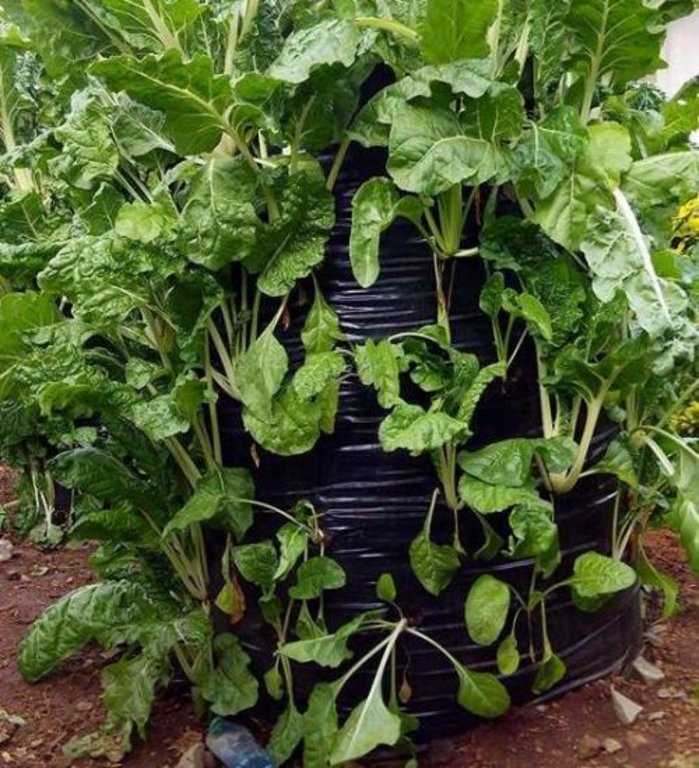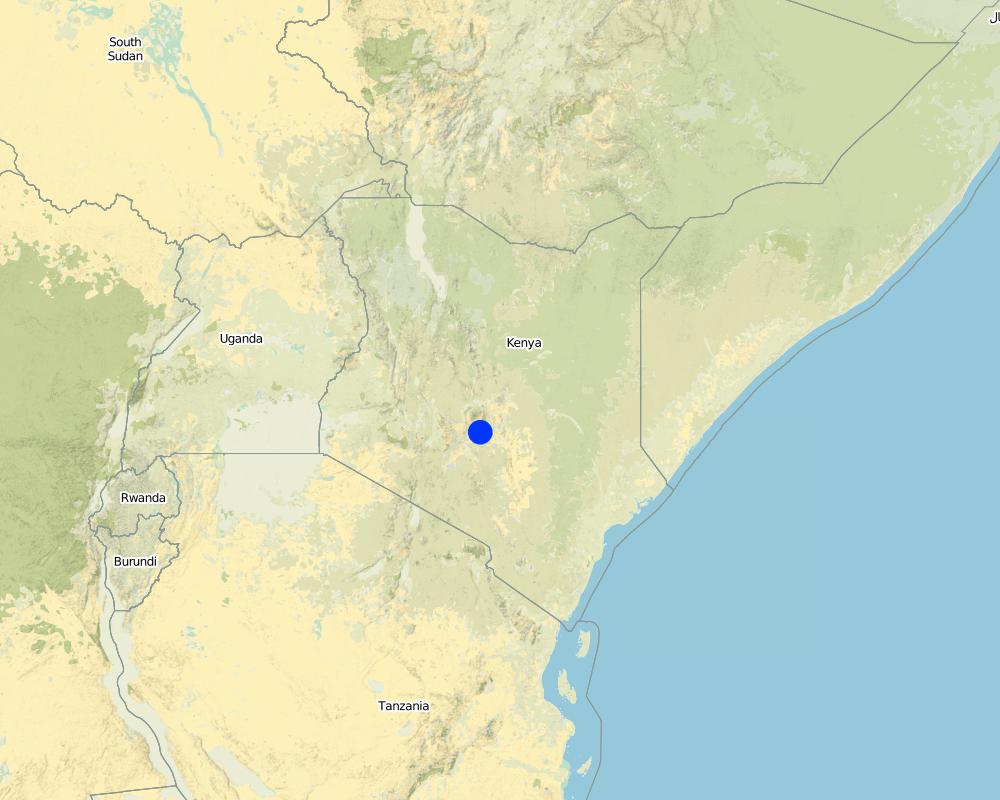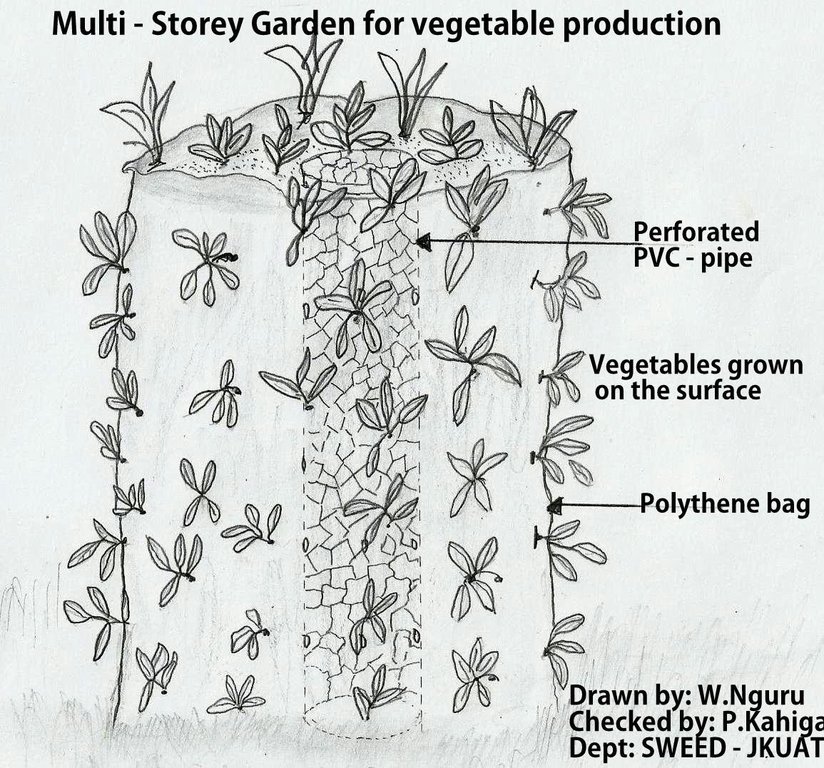Multistorey Gardens [Kenya]
- Creation:
- Update:
- Compiler: Paul Kahiga
- Editor: –
- Reviewers: Fabian Ottiger, Alexandra Gavilano
Multistorey Gardens
technologies_1322 - Kenya
View sections
Expand all Collapse all1. General information
1.2 Contact details of resource persons and institutions involved in the assessment and documentation of the Technology
SLM specialist:
Gathenya Mwangi
Jomo Kenyatta University of Agriculture and Technology
Kenya
SLM specialist:
Home Patrick
Jomo Kenyatta University of Agriculture and Technology
Kenya
SLM specialist:
Chege Timothy
Jomo Kenyatta University of Agriculture and Technology
Kenya
SLM specialist:
Adamba Omwange
Jomo Kenyatta University of Agriculture and Technology
Kenya
SLM specialist:
Baobab Kimengich
Jomo Kenyatta University of Agriculture and Technology
Kenya
SLM specialist:
Wamuongo Jane
Kenya Agricultural Research Institute
Kenya
SLM specialist:
Karanja Andrew
Kenya Agricultural Research Institute
Kenya
SLM specialist:
Namirembe Sara
World Agroforestry Centre (ICRAF)
Kenya
Name of the institution(s) which facilitated the documentation/ evaluation of the Technology (if relevant)
Jomo Kenyatta University (Jomo Kenyatta University) - KenyaName of the institution(s) which facilitated the documentation/ evaluation of the Technology (if relevant)
KARI Headquarters (KARI Headquarters) - KenyaName of the institution(s) which facilitated the documentation/ evaluation of the Technology (if relevant)
International Centre for Research in Agroforestry (ICRAF) - Kenya1.3 Conditions regarding the use of data documented through WOCAT
The compiler and key resource person(s) accept the conditions regarding the use of data documented through WOCAT:
Yes
1.4 Declaration on sustainability of the described Technology
Is the Technology described here problematic with regard to land degradation, so that it cannot be declared a sustainable land management technology?
No
2. Description of the SLM Technology
2.1 Short description of the Technology
Definition of the Technology:
Multistory gardens refer to upright polythene sack filled with soil, in which food crops like vegetables, kales, carrots or onions grow on its sides.
2.2 Detailed description of the Technology
Description:
Multistory gardening is an innovative and exciting technology for year round vegetable gardening. Multi-storey farming not only makes efficient use of water but it is also safe from droughts and floods.
Purpose of the Technology: This micro-gardening concept being a low input activity is ideal where labor and other resources are scarce. Multi-storey gardens lead to development of self reliance in vegetables for nutrition and food security in the vulnerable households.
Establishment / maintenance activities and inputs: Materials required for multi-storey gardening include empty cereal bag or animal feed bag, one empty oil can or 6”PVC pipe with holes, 2buckets small stones, 6 buckets soil, 6 buckets manure, seeds, adequate water to irrigate the bag garden and gardening tools. The following procedure is used to set up the garden. 1) Mix the soil and well decomposed manure thoroughly. 2) Cut out the bottom of the oil can and make holes on the sides. 3) Fold back the bag and fill the bottom 15cm with small stones. 4) Place the can on top of the small stones in the center of the bag. 5) Fill the oil can with small stones 6) Fill the area between the oil can and the bag with the soil-manure mixture up to the can level. 7) Pull up the can to the level of the soil compost mixture with a tilting motion. Repeat steps 5, 6 and 7 until the bag is full and a central core of stones is formed leaving the tin at the top of the bag garden. Pour water into the tin through the central core till the soil is soaked.
Natural / human environment: Multistory gardens technology is suitable for urban gardening in Kenya where land for farming has greatly reduced due to urbanization.These bag gardens are also suitable for dry, non fertile areas where soils are not suitable for conventional gardening, areas with water scarcity..
2.3 Photos of the Technology
2.5 Country/ region/ locations where the Technology has been applied and which are covered by this assessment
Country:
Kenya
Region/ State/ Province:
Eastern Province
Further specification of location:
Embu
Specify the spread of the Technology:
- evenly spread over an area
If precise area is not known, indicate approximate area covered:
- < 0.1 km2 (10 ha)
Map
×2.6 Date of implementation
If precise year is not known, indicate approximate date:
- less than 10 years ago (recently)
2.7 Introduction of the Technology
Specify how the Technology was introduced:
- through projects/ external interventions
3. Classification of the SLM Technology
3.1 Main purpose(s) of the Technology
- improve production
- adapt to climate change/ extremes and its impacts
- create beneficial economic impact
3.2 Current land use type(s) where the Technology is applied

Cropland
- Annual cropping
Annual cropping - Specify crops:
- vegetables - leafy vegetables (salads, cabbage, spinach, other)
- vegetables - root vegetables (carrots, onions, beet, other)
Number of growing seasons per year:
- 1
Specify:
Longest growing period in days: 180, Second longest growing period in days: 180
Comments:
Food crops like vegetables, kales, carrots, onions and spinach
Major land use problems (compiler’s opinion): Effects of strong moving wind causes great soil erosion, but the presence of multistorey crops alternates the wind energy, hence lowering its effects.
Major land use problems (land users’ perception): Greatest soil erosion and also bending of crops in the farms
Constraints of settlement / urban
3.4 Water supply
Water supply for the land on which the Technology is applied:
- mixed rainfed-irrigated
3.5 SLM group to which the Technology belongs
- home gardens
3.6 SLM measures comprising the Technology

agronomic measures
- A1: Vegetation/ soil cover

vegetative measures
- V2: Grasses and perennial herbaceous plants
Comments:
Type of agronomic measures: better crop cover
3.7 Main types of land degradation addressed by the Technology

soil erosion by wind
- Et: loss of topsoil
Comments:
Main causes of degradation: soil management, urbanisation and infrastructure development, land tenure
3.8 Prevention, reduction, or restoration of land degradation
Specify the goal of the Technology with regard to land degradation:
- prevent land degradation
- restore/ rehabilitate severely degraded land
4. Technical specifications, implementation activities, inputs, and costs
4.1 Technical drawing of the Technology
Technical specifications (related to technical drawing):
This is a technical drawing showing a typical multi-storey garden technology for vegetable production. It comprises of a perforated polythene bag with a central Perforated PVC pipe (for water application) and vegetables planted on the outer surfaces.
Location: Mbeere South District. Eastern Province
Main technical functions: spatial arrangement and diversification of land use
Better crop cover
Material/ species: vegetables (kales and spinach)
Quantity/ density: 8
Remarks: per line
Author:
Paul Kahiga, 62000-00200 Nairobi
Date:
28/10/2012
4.2 General information regarding the calculation of inputs and costs
other/ national currency (specify):
Kshs
If relevant, indicate exchange rate from USD to local currency (e.g. 1 USD = 79.9 Brazilian Real): 1 USD =:
100.0
Indicate average wage cost of hired labour per day:
500.00
4.3 Establishment activities
| Activity | Timing (season) | |
|---|---|---|
| 1. | Purchase polythene bag | |
| 2. | Purchase manure (FYM) | |
| 3. | Purchase seedlings |
Comments:
Lifespan of the polythene bag: 5 years
Lifespan of the manure: 1 year
Lifespan of the seedlings: 1 year
4.4 Costs and inputs needed for establishment
| Specify input | Unit | Quantity | Costs per Unit | Total costs per input | % of costs borne by land users | |
|---|---|---|---|---|---|---|
| Labour | Labour | Labour per 10 bags | 2.0 | 2.5 | 5.0 | 100.0 |
| Equipment | Tools | ha | 1.0 | 20.0 | 20.0 | 100.0 |
| Plant material | Seedlings | Seedlings | 320.0 | 0.00156 | 0.5 | 92.0 |
| Fertilizers and biocides | Manure | 20.0 | 0.05 | 1.0 | 100.0 | |
| Construction material | Polythene bag | Bags | 10.0 | 0.25 | 2.5 | 100.0 |
| Total costs for establishment of the Technology | 29.0 | |||||
| Total costs for establishment of the Technology in USD | 0.29 | |||||
Comments:
Duration of establishment phase: 1 month(s)
4.5 Maintenance/ recurrent activities
| Activity | Timing/ frequency | |
|---|---|---|
| 1. | weeding | 2 |
| 2. | harvesting | 3 per week |
4.6 Costs and inputs needed for maintenance/ recurrent activities (per year)
| Specify input | Unit | Quantity | Costs per Unit | Total costs per input | % of costs borne by land users | |
|---|---|---|---|---|---|---|
| Labour | Weeding | Mandyas | 3.0 | 0.8333 | 2.5 | 100.0 |
| Labour | Harvesting | Mandays | 1.0 | 2.5 | 2.5 | 100.0 |
| Equipment | Tools | Ha | 1.0 | 2.0 | 2.0 | 100.0 |
| Total costs for maintenance of the Technology | 7.0 | |||||
| Total costs for maintenance of the Technology in USD | 0.07 | |||||
4.7 Most important factors affecting the costs
Describe the most determinate factors affecting the costs:
Labor is the most determinate factor affecting the costs.
5. Natural and human environment
5.1 Climate
Annual rainfall
- < 250 mm
- 251-500 mm
- 501-750 mm
- 751-1,000 mm
- 1,001-1,500 mm
- 1,501-2,000 mm
- 2,001-3,000 mm
- 3,001-4,000 mm
- > 4,000 mm
Agro-climatic zone
- semi-arid
Thermal climate class: tropics
5.2 Topography
Slopes on average:
- flat (0-2%)
- gentle (3-5%)
- moderate (6-10%)
- rolling (11-15%)
- hilly (16-30%)
- steep (31-60%)
- very steep (>60%)
Landforms:
- plateau/plains
- ridges
- mountain slopes
- hill slopes
- footslopes
- valley floors
Altitudinal zone:
- 0-100 m a.s.l.
- 101-500 m a.s.l.
- 501-1,000 m a.s.l.
- 1,001-1,500 m a.s.l.
- 1,501-2,000 m a.s.l.
- 2,001-2,500 m a.s.l.
- 2,501-3,000 m a.s.l.
- 3,001-4,000 m a.s.l.
- > 4,000 m a.s.l.
5.3 Soils
Soil depth on average:
- very shallow (0-20 cm)
- shallow (21-50 cm)
- moderately deep (51-80 cm)
- deep (81-120 cm)
- very deep (> 120 cm)
Soil texture (topsoil):
- medium (loamy, silty)
Topsoil organic matter:
- medium (1-3%)
If available, attach full soil description or specify the available information, e.g. soil type, soil PH/ acidity, Cation Exchange Capacity, nitrogen, salinity etc.
Soil fertility: Medium
Soil drainage/infiltration: Medium
Soil water storage capacity: Medium
5.4 Water availability and quality
Ground water table:
5-50 m
Availability of surface water:
medium
Water quality (untreated):
for agricultural use only (irrigation)
5.5 Biodiversity
Species diversity:
- medium
5.6 Characteristics of land users applying the Technology
Market orientation of production system:
- mixed (subsistence/ commercial)
Off-farm income:
- less than 10% of all income
Relative level of wealth:
- average
Individuals or groups:
- individual/ household
Level of mechanization:
- manual work
Indicate other relevant characteristics of the land users:
Land users applying the Technology are mainly common / average land users
Population density: 10-50 persons/km2
Annual population growth: < 0.5%
5.7 Average area of land used by land users applying the Technology
- < 0.5 ha
- 0.5-1 ha
- 1-2 ha
- 2-5 ha
- 5-15 ha
- 15-50 ha
- 50-100 ha
- 100-500 ha
- 500-1,000 ha
- 1,000-10,000 ha
- > 10,000 ha
Is this considered small-, medium- or large-scale (referring to local context)?
- small-scale
5.8 Land ownership, land use rights, and water use rights
Land use rights:
- individual
Water use rights:
- individual
5.9 Access to services and infrastructure
technical assistance:
- poor
- moderate
- good
6. Impacts and concluding statements
6.1 On-site impacts the Technology has shown
Socio-economic impacts
Production
crop production
risk of production failure
Water availability and quality
demand for irrigation water
Income and costs
diversity of income sources
Socio-cultural impacts
food security/ self-sufficiency
Improved livelihoods and human well-being
Comments/ specify:
Improves dietary diversification
6.3 Exposure and sensitivity of the Technology to gradual climate change and climate-related extremes/ disasters (as perceived by land users)
Climate-related extremes (disasters)
Meteorological disasters
| How does the Technology cope with it? | |
|---|---|
| local rainstorm | well |
6.4 Cost-benefit analysis
How do the benefits compare with the establishment costs (from land users’ perspective)?
Short-term returns:
positive
Long-term returns:
positive
How do the benefits compare with the maintenance/ recurrent costs (from land users' perspective)?
Short-term returns:
positive
Long-term returns:
positive
6.5 Adoption of the Technology
Comments:
There is a little trend towards spontaneous adoption of the Technology
Comments on adoption trend: It is a new technology
6.7 Strengths/ advantages/ opportunities of the Technology
| Strengths/ advantages/ opportunities in the land user’s view |
|---|
| Growing of vegetables all year round and less water is used for irrigation |
| Labour efficient means of increasing food security |
| Strengths/ advantages/ opportunities in the compiler’s or other key resource person’s view |
|---|
| Multi-storey gardens contributes to dietary diversification among the practicing communities. |
| Contributes to income generation. |
| Encourages self reliance and empowers women in rural areas. |
7. References and links
7.1 Methods/ sources of information
- field visits, field surveys
- interviews with land users
When were the data compiled (in the field)?
19/09/2012
Links and modules
Expand all Collapse allLinks
No links
Modules
No modules





